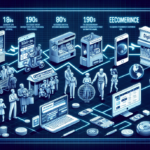Who Invented Ecommerce? A Look at the Pioneers of Online Shopping
Electronic commerce, commonly known as ecommerce, is the act of buying and selling goods and services online. While the concept of ecommerce has been around since the inception of the internet, it wasn't until the mid-1990s that it began to gain significant traction. The advent of ecommerce has revolutionized the way we shop, making online transactions more convenient and efficient. In this article, we'll delve into the pioneers of online shopping and explore the evolution of ecommerce.
The First Online Purchase: A Brief History of Ecommerce
The first recorded online purchase was made in 1994 by Phil Brandenberger, who bought a CD of Sting's Ten Summoner's Tales from NetMarket. This milestone marked the beginning of ecommerce, leading to a surge of companies entering the online marketplace. Among these pioneers was Amazon, founded by Jeff Bezos in 1994 as an online bookstore. Amazon quickly expanded its offerings, evolving into a comprehensive online marketplace for a wide range of products.
In 1995, eBay was established, providing a platform for individuals to buy and sell goods through online auctions. These early movers laid the foundation for the ecommerce industry, setting the stage for its exponential growth.
According to Statista, global ecommerce sales reached approximately $5.2 trillion in 2023, highlighting the significant impact and growth of online shopping over the past decades.
The Evolution of Online Shopping: From Dial-Up to Mobile Commerce
Advancements in Internet Technology
The evolution of internet technology has been pivotal in shaping the ecommerce landscape. The transition from dial-up connections to high-speed broadband and fiber optics has drastically improved the online shopping experience, enabling faster load times and more seamless transactions.
The Rise of Mobile Commerce
With the proliferation of smartphones, mobile commerce (m-commerce) has become a dominant force in ecommerce. As of 2023, over 70% of global ecommerce sales are conducted via mobile devices, necessitating that businesses prioritize mobile-friendly website designs and applications to cater to on-the-go consumers.
Integration of Social Media Platforms
Social media platforms like Facebook, Instagram, and Pinterest have emerged as significant sales channels. These platforms offer integrated shopping features, allowing users to purchase products directly from their social media feeds. This integration has blurred the lines between social media and ecommerce, providing businesses with new avenues to reach and engage customers.
Artificial Intelligence and Machine Learning
Artificial intelligence (AI) and machine learning have transformed the online shopping experience by enabling personalized recommendations and chatbots that assist customers in real-time. These technologies analyze user behavior and preferences to enhance the efficiency and convenience of online shopping.
The Impact of Amazon and eBay on the Ecommerce Landscape
Amazon's Dominance and Innovation
Amazon has significantly influenced the ecommerce industry through innovations like Amazon Prime, which offers expedited shipping and exclusive services. Additionally, Amazon has diversified into areas such as cloud computing with AWS, streaming services, and even physical retail stores, solidifying its position as a multifaceted conglomerate.
eBay's Pioneering Online Auctions
eBay revolutionized ecommerce by introducing the concept of online auctions, providing a platform for individuals to buy and sell goods globally. This model has fostered a vibrant marketplace where unique and rare items can be traded, promoting entrepreneurship and facilitating small-scale commerce.
Supporting Small Businesses
Both Amazon and eBay have democratized access to the ecommerce market, allowing small businesses and individual sellers to reach a global audience without the need for significant upfront investment in physical storefronts. This accessibility has spurred entrepreneurship and contributed to the diverse range of products available online.
The Role of Social Media in the Growth of Ecommerce
Social Media as a Marketing Tool
Social media platforms serve as powerful marketing channels for ecommerce businesses. Through targeted advertising and influencer partnerships, companies can effectively promote their products to specific demographics, enhancing brand visibility and driving sales.
Data-Driven Insights
Social media provides valuable data on customer preferences and behaviors. Ecommerce companies leverage this data to tailor their marketing strategies, optimize product offerings, and improve the overall customer experience.
Seamless Shopping Experiences
The integration of shopping features within social media platforms allows users to make purchases without leaving the app. This seamless experience reduces friction in the buying process, increasing conversion rates and customer satisfaction.
How Cybersecurity Has Changed the Way We Shop Online
Enhanced Security Measures
As ecommerce has grown, so have concerns over cybersecurity. To protect consumer data, ecommerce companies have implemented robust security measures such as SSL encryption, two-factor authentication, and secure payment gateways. These measures help build trust and ensure safe transactions for customers.
AI and Machine Learning in Cybersecurity
AI and machine learning technologies play a crucial role in detecting and preventing cyber threats in real-time. These technologies analyze patterns and anomalies to identify potential security breaches, allowing companies to respond swiftly to protect sensitive information.
Blockchain for Data Security
Blockchain technology offers a decentralized and transparent method of securing transactions and data storage. Some ecommerce companies are adopting blockchain to enhance the security and integrity of their payment systems, further safeguarding customer information.
The Future of Ecommerce: Predictions and Trends to Watch Out For
Continued Growth of Mobile Commerce
Mobile commerce is expected to continue its upward trajectory, driven by advancements in mobile payment technologies and the increasing use of smartphones for online shopping. Businesses will need to prioritize mobile optimization to cater to this growing market.
Artificial Intelligence and Personalization
AI will further enhance personalization in ecommerce, providing customers with more tailored shopping experiences. From personalized product recommendations to AI-driven customer service, these innovations will drive customer engagement and loyalty.
Virtual and Augmented Reality
Virtual reality (VR) and augmented reality (AR) technologies are set to transform the online shopping experience by allowing customers to virtually try on products, visualize items in their space, and interact with products in immersive environments.
Sustainable Ecommerce Practices
Sustainability is becoming a key consideration for consumers. Ecommerce companies are responding by offering eco-friendly products, utilizing sustainable packaging, and implementing green logistics practices. These efforts not only appeal to environmentally conscious consumers but also contribute to broader sustainability goals.
A Comparison of Different Ecommerce Models: B2B, B2C, and C2C
Business-to-Business (B2B)
B2B ecommerce involves transactions between businesses, such as manufacturers selling to wholesalers or distributors selling to retailers. This model often involves larger order volumes and longer sales cycles compared to consumer-focused models.
Business-to-Consumer (B2C)
B2C ecommerce is the most prevalent model, where businesses sell directly to consumers. This model focuses on providing a seamless and engaging shopping experience, emphasizing marketing and customer service to attract and retain individual buyers.
Consumer-to-Consumer (C2C)
C2C ecommerce facilitates transactions between consumers, typically through platforms like eBay or Etsy. This model empowers individuals to sell goods directly to other consumers, fostering a community-driven marketplace.
Choosing the Right Model
Each ecommerce model presents unique challenges and opportunities. Businesses must carefully assess their target market, product offerings, and operational capabilities to select the model that best aligns with their goals and resources.
The Importance of User Experience in Ecommerce Websites
Website Navigation and Design
A user-friendly website with intuitive navigation is essential for retaining customers. Clear categorization, search functionality, and responsive design contribute to a positive user experience, making it easier for customers to find and purchase products.
Checkout Process
A streamlined and secure checkout process is vital for reducing cart abandonment rates. Offering multiple payment options, simplifying form fields, and ensuring transparency in pricing and shipping details enhance the overall shopping experience.
Page Load Speed
Fast-loading pages are crucial for maintaining customer engagement. Slow websites can lead to frustration and increased bounce rates, negatively impacting sales and customer satisfaction. Optimizing images, leveraging content delivery networks (CDNs), and minimizing server response times are key strategies for improving load speeds.
The Challenges Faced by Small Businesses in the Ecommerce Industry
Competition with Large Retailers
Small businesses often struggle to compete with larger ecommerce giants on pricing, shipping speed, and product variety. Differentiating through unique products, personalized customer service, and niche marketing strategies can help small businesses carve out their own space in the market.
Marketing and Visibility
Gaining visibility in a saturated market is a significant challenge for small businesses. Effective use of digital marketing channels such as social media, search engine optimization (SEO), and email marketing can enhance brand awareness and attract customers.
Resource Constraints
Limited financial and human resources can hinder the ability of small businesses to scale and innovate. Leveraging ecommerce platforms that provide built-in tools and integrations can help small businesses manage operations more efficiently and focus on growth.
In conclusion, ecommerce has evolved tremendously since its inception, with pioneers like Amazon and eBay paving the way for a dynamic and expansive industry. As technology continues to advance and consumer preferences shift, ecommerce will undoubtedly continue to adapt and innovate. Whether you're a large corporation or a small business, understanding these trends and challenges is essential for succeeding in the ever-changing world of online commerce.




















